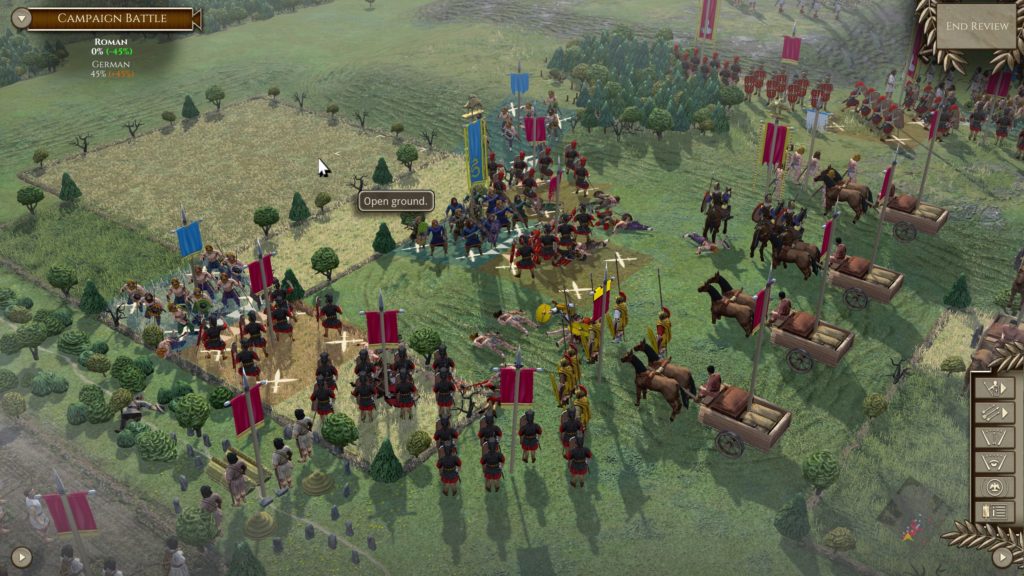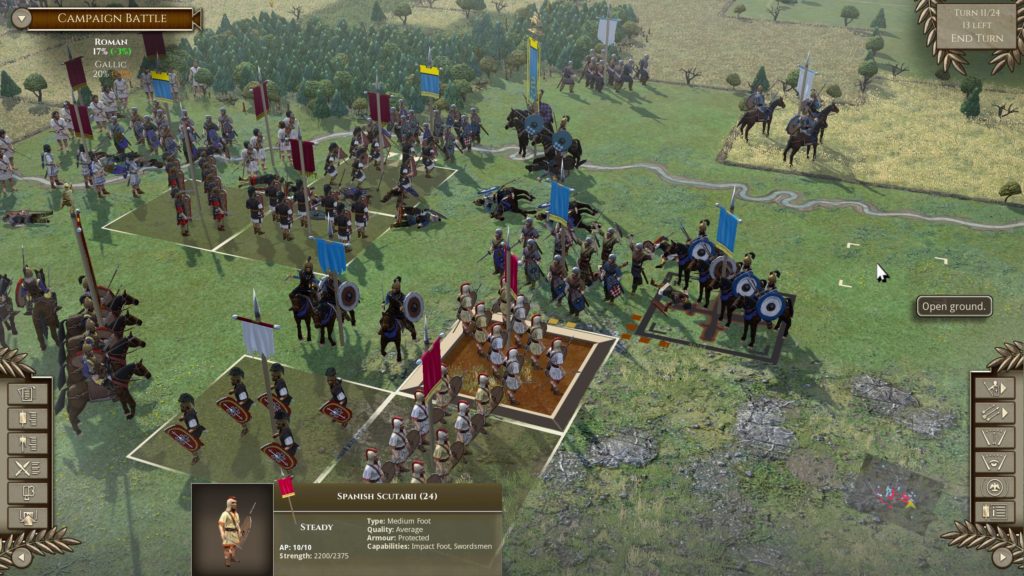
Tabletop wargaming is of course the ultimate in grognard hobbies, especially historical ones. I will never of course actually play a tabletop wargame, never mind go to the immense expense and effort to buy and paint miniatures. But from time to time, I do wonder what the rules for one might be like and how it might feel to play it. Enter Field of Glory 2 which aims to recreate this sort of experience on the PC, minus the miniature collecting and painting part of course. I don’t know if this is actually a popular ruleset for wargamers but I do know that they publish a hardback rulebook for this so it is a real tabletop wargame.
This is a straightforward wargame meant to recreate the ancient battles of Rome and the other nations of that era. Although there are single-player campaigns, those are really just a fixed series of six or seven battles that allow you bring forward a portion of your surviving army after each battle. There’s no strategic layer at all. You don’t even get full freedom to build your army as you wish in the campaigns and you have a core army that I suppose must be historically accurate plus some points left over to buy extra units. The graphics are much better than just plain counters on a flat map but it is very basic compared to the Total War games that more people will be familiar with. Everything in here is turn-based so you move each unit on your side until you’re done and pass the turn over to the opponent. This can take a while as an army can consist of dozens of units.
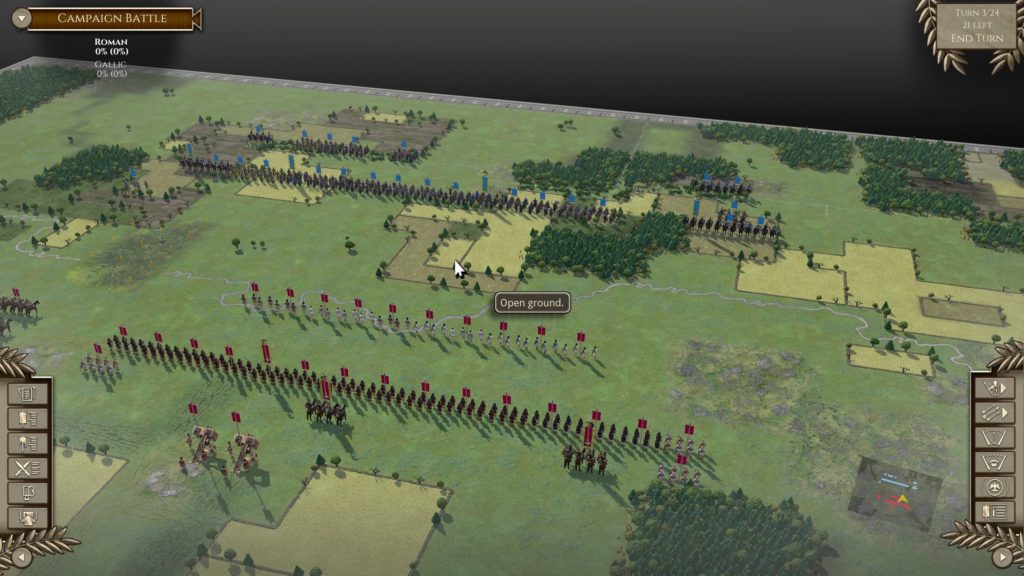
The real meat of the game is of course the ruleset, how well it simulates realistic battles and how well the AI performs in single-player. As you might expect learning the rules is no mean feat and the included tutorial is not much help. In fact, I would consider the last chapter of the tutorial to be the hardest so-called tutorial I’ve ever played as it is quite a serious challenge. Reading the manual is helpful but I really had to resort to YouTube to really understand what I’m supposed to do. The difficulty is that each unit is defined in terms of its capabilities and they match up in different ways against enemy units. When two units meet in melee, the first round is a charge and subsequent ones are melees and different units perform different in charges and melees. For example, when a unit of spearmen and a unit of swordsmen clash, you can expect the swordsmen to have an advantage but provided that the spearmen can survive that first charge well, they can actually slowly grind out a victory against the swordsmen in subsequent melee rounds. To play this game well, you have to memorize this and all other sets of interactions between different units.
This being the kind of game that it is, all this is complicated by many, many factors. Terrain type matters as does elevation. Heavy infantry needs flat terrain to work in while medium infantry can hold rough terrain. Flank and rear attacks against an already engaged enemy unit all but guarantees it will break on contact. The presence of a general within a unit provides a substantial bonus and you can even shift a general from one unit to another during a battle. Unengaged units exert a zone of control so you can’t just ignore one unit to go attack another one nearby. Units are hard to turn and get in one another’s way all the time. Light units can skirmish and tend to dance away when you try to pin them down in melee. Elephants scare all other mounted units, even your own. Cavalry and undisciplined heavy infantry will try to chase down routing enemies, often leading them to end up in exposed positions.
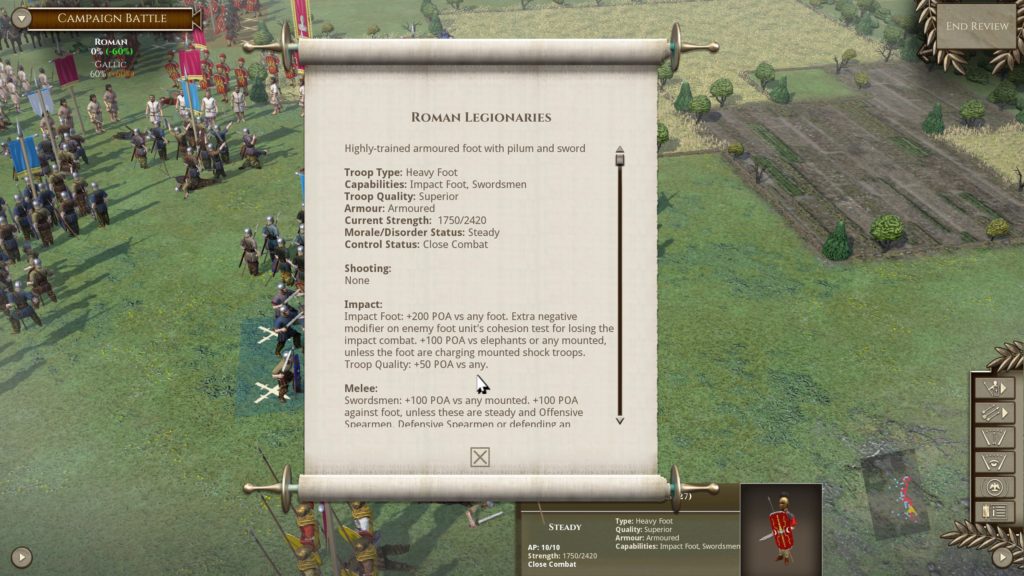
With the sheer number of units in the game, that’s a lot to take in and in the end it mostly comes down to experience in knowing how best each unit works. For example, using light foot skirmishers seems to work best in groups of three as three volleys of missile fire are usually enough to disrupt an enemy unit. I like to make sure that one of these units are javelin guys because they have shorter range but far better charge and melee capabilities. These rules succeed in creating complicated situations that you must think through carefully to solve. Cavalry for example should be nervous about hanging out at the fringes of woods even if you have no intention of charging them into it. Skirmishers can use them as cover to hide and pepper your mounted troops with missile to which you have no answer. If you try to chase them down, they just run into the woods. If you try to leave, they come up from behind you and keep shooting. Similarly medium infantry are incredibly weak to heavy infantry and heavy cavalry out in the open. But give them some rough terrain to hold and it can be impossible to chase them out without medium infantry or missile troops of your own.
All these are like small tactical puzzles but battles can be quite epic in scope and consist of many of these smaller knots of units. Most battles have the winning condition of either routing 40% of the enemy army while ensuring enemy losses are 25% more than your own or outright routing 60% of the enemy army. This means that the objective will be to try to achieve local superiority while trying to delay combat as much as possible where you are weak. The advice is that you must go into battle with a plan and this can so detailed that you must think of which unit of your own will be matched with an opposing enemy unit and where they will meet, given the terrain and the probable movement of the enemy. That’s why I found this game to be very mentally taxing when the battles become too big. I basically opened one of the historical epic battles, looked at all of the units on sides , thought briefly of the calculations it would take to plan out the whole battle taking everything into account and noped out.
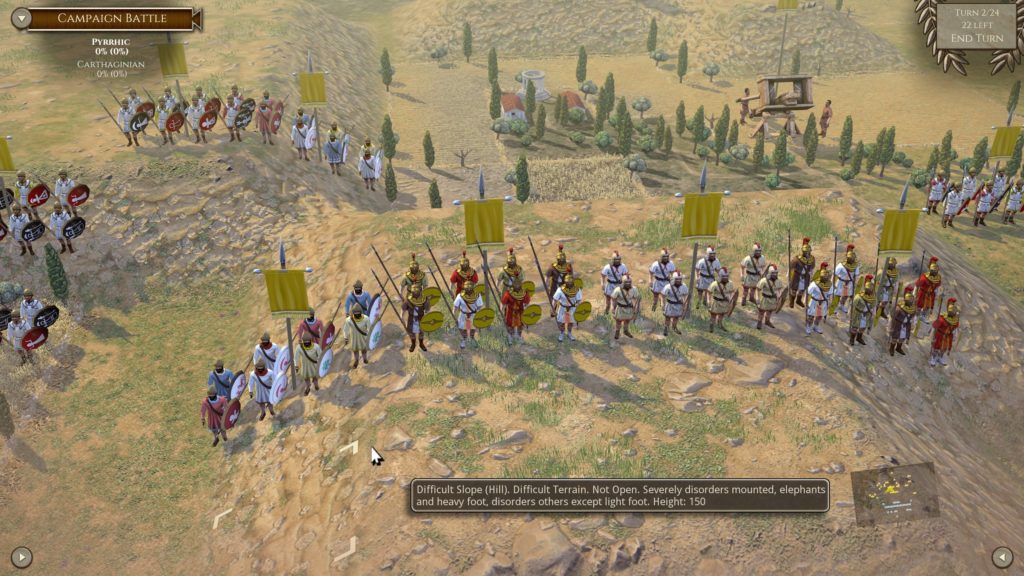
There are just so many things to think about. On which flank will you be attacking and on which flank you will be trying to defend? Where do you place your generals? Do you have enough cavalry to dominate the enemy cavalry and if so how far from the main battle line do you let them roam? How do you deal with enemy skirmishers who try to break up your main battle line? Have you planned for that patch of rough ground in the middle where you think the two armies will meet? This is far more involved and complicated than any of the Total War games especially as the turn-based nature of the game and the very limited movement that each unit can make in a turn forces you to plan far ahead. One single mistake could leave a unit momentarily vulnerable to a flank charge which the AI is certainly clever enough to exploit and instantly get it annihilated in a round. I’m sure that good players can outplay the AI but the AI certainly outplays me most of the time especially as it is far more astute about using the zone of control rules to protect its weakest units.
The base game comes with, I believe, four campaigns and the historical epic battles. I completed the campaigns for Julius Caesar and Pyrrhos of Epeiros but skipped over the ones for Hannibal, because I dislike using the unreliable and expensive elephants, and Mithridates of Pontus, because his first battle is against a basically cavalry-only force which I found very frustrating to catch with infantry. But I always knew that this is too specialized a genre for me and I won’t actually want to spend so much time and effort to properly master it. I have however played enough to satisfy my curiosity about what these tabletop wargames are like and I enjoyed the time I spent doing so. Clearly this is a game with its own dedicated community and organized tournaments and as far as I can tell it that is because it does work at reasonably approximating what those historical battles were like. For those who are interested in learning more it, I strongly recommend the YouTube channel of this guy who has even written a book on the subject!
